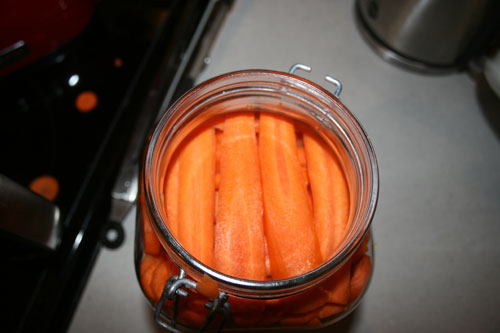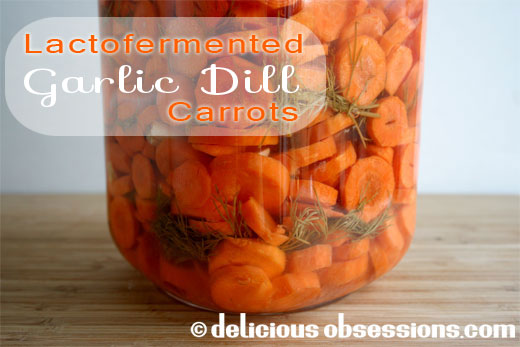FTC Disclosure: Delicious Obsessions may receive comissions from purchases made through links in this article. As an Amazon Associate I earn from qualifying purchases.Read our full terms and conditions here.
For week 21, I shared my recipe for Dilly Carrots with you. That recipe was done in a regular Fido jar which resulted in a much better tasting ferment than I ever got with a Mason jar.
Since that post, I have started using anaerobic fermenting vessels and recommend the ones from my affiliate partner, The Probiotic Jar. I have revised the original recipe for those types of jars. The main difference between my old recipe and my new recipe is that we no longer use whey and the brine is different.
These carrots are delicious. They are garlicky and tangy from the fermentation, a hint of dill, and not nearly as salty as my previous version. That’s because, in the anaerobic jars, the brine is different and tends to be much less salty than the brine that we are all accustomed to from the Mason jar days.
These carrots taste best when they are really cold. Kids love them, so I hear, so if you’ve got some picky eaters in the house, you might try this ferment on them and see if they like it!
Lactofermented Garlic and Dill Carrots (Updated)
makes approx 2 liters
Ingredients
- 16 large carrots, chopped into coins (about 1/4 inch thick – I used my awesome food processor)
- 5 cloves fresh garlic, sliced, diced, or crushed (your choice)
- 1 bunch fresh dill (more or less to taste)
- 1 quart of 2% brine (19 grams of salt to 4 cups of water)
- 1 extra carrot for your weight (more about this below)
Instructions
- Slice your carrots into coins. I used my food processor on the thickest setting for this. You could also do carrot sticks if you prefer.
- Slice your fresh garlic and place in the bottom of your anaerobic jar.
- Add your fresh dill (washed and left whole, not chopped) to the bottom of the jar with the garlic. I kind of layered mine a little, as you can see in the picture above.
- Pack the carrots into the jar, as tightly as you can. If you do sticks, you can stack them to make a snug fit. If you use the coins, then just pack them as best you can. Only fill the jar to the shoulder and never above. You need to leave some expansion room. Really pack them in there. Use your fist to press the carrots firmly into the jar.
- Take your extra carrot and make some very thin slices, about 3 inches long and about 1/8 inch thick. You will need about 8 of these slices.
- Place your carrot slices across the top of the carrots that are being fermented. This will create a type of “floor”, where your weight can sit. It will help keep all of the carrot submerged and help them ferment completely. See picture below.

7. Place your weight on the “floor”. See picture below.

8. Pour your brine over your carrots. you want the brine to cover the top of the weight, but not be too much higher than the shoulder. You need a good inch of expansion space. Press down on the weight firmly to remove any air bubbles that may have gotten caught. Do this carefully, as not to dislodge your “floor”.
9. Insert the airlock into the anaerobic jar’s lid and add 1.5 tbsp. of water. Close the latch on the lid and make sure it is secure.
10. Move your carrot to a spot in your house where it will can be undisturbed for about a week. Wrap the jar in a towel to keep out any UV light, which damages the bacteria.
11. Let the carrots go for 2-3 days and then check them. You should see bubbles on the inside of the jar. This means there is active fermentation happening. The carrots will be done when there are no more bubbles rising to the top (mine took 7 days). You can tap the jar to see if there are any bubbles. When there are no more, you can move to the fridge and let chill completely before eating.


17 Comments